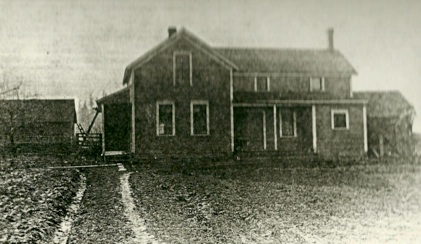As the number of people doubled between 1750 and 1850 in Europe and the population continued to grow, the burden was carried by the agricultural society. There was a series of hunger problems. 1867 began a series of crop failures “the wet year.” 1868 was “the dry year.” 1869 “the severe year” with epidemics and begging children. Many thousands of people left during these “starvation years.”


Germans

Germans — John F. Hamel and Fred Hamel
John F. Hamel was German and his wife, Matilda, was Swiss. They were early settlers. Their first child was born here in 1876. Over the years they had six children. John died at the age of 41 in 1895 leaving Matilda to run the farm and care for the children.
Fred Hamel was German and settled in the “beaverdam” area with his wife Emily and their family. He along with his neighbors, the Keehns’ and Nels Johnson, cleared their land and built their homes. The need for a school became important to them as their families grew. Over the years, trees were cut, stumps removed, and the land cultivated. The “beaverdam land provided rich soil for the grain crops. Fred, a very successful farmer, “sent out 26 horses into the field to work. He cut 5000 acres in 11 years.” Walter Stucki

German Brothers —Ernest and Albert Keehn
Ernest H. Keehn and Albert F. Keehn were brothers who settled the area with their families and older parents, Frederick and Minnie Keehn. In 1889, Earnest (age 29) and Albert (age 25) built the first McKinley School a simple 20 x 30 structure. Also in 1889 Anna (Albert’s future wife) arrived in New York from Germany. She was only 16 at that time. She took the train from New York across the United States to Washington County. Four years later she and Albert were married. Their children went to the school their father and uncle had built—McKinley.
Ernest was a lumberman and eventually owned a sawmill. William Keehn (age 37) was on the school board of directors. [Although William’s property is near the other Keehn brothers, the relationship is unknown.]
Julius Foege
Julius Foege was born in Germany, September of 1860. In 1889, at age 29, he married Elizabeth Foege. That is also the year he and Alert Keehn paced off the land between Walker Road and Cornell Road to find the middle point to build the first local school. Eventually they had children who attended that school. In 1949 at McKinley’s 60th year reunion, he and Elizabeth attended. Julius was 89 at that time. Julius built a home were he and his wife lived for 75 years. Elizabeth lived to be 101.
The Foege children went to McKinley. Daughter, Alma, and son, George, attended the 1989 Centennial Celebration Alma was age 97at that time. (She went on to live to 101 like her mother.) Son, George, was14 years younger than Alma. At the Cntennial Party, George was age 83.

Foege Family photo

